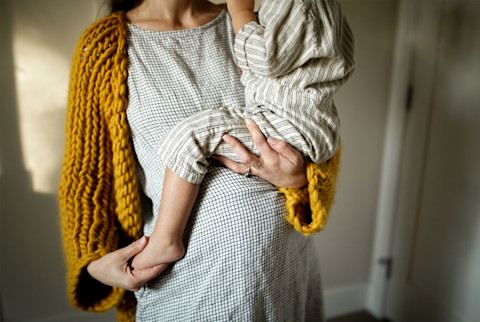Microplastics In Placental Tissue May Help Explain Unexplained Miscarriages

We've known for a while now that microplastics have infiltrated nearly every corner of our environment, from the deepest ocean trenches to the air we breathe. But new research has uncovered (yet another) place these plastics are lurking: These tiny plastic particles are accumulating in placental tissue during early pregnancy, and they might be connected to miscarriage risk.
A new study1 examined chorionic villi (the finger-like projections that form the early placenta) from 31 women in their first trimester. What researchers found was both revealing and concerning: Every single sample contained microplastics, and women who experienced unexplained miscarriage had significantly higher concentrations than those with normal pregnancies.
This isn't just another abstract environmental concern. It's a tangible link between the plastic pollution in our daily lives and one of the most vulnerable moments in human development.
How researchers measured plastic in pregnancy tissue
The research team collected chorionic villi samples from two groups of participants: 18 women who experienced unexplained spontaneous miscarriage and 13 women with normal pregnancies that were terminated for personal reasons (serving as the control group). All participants were in their first trimester, between six and eight weeks of pregnancy.
Using a sophisticated technique (called pyrolysis-gas chromatography/mass spectrometry, if you’re curious), scientists were able to identify and measure 11 different types of microplastics in the tissue. This method is particularly powerful because it can detect plastics regardless of their size, giving researchers a complete picture of what's actually accumulating in these critical pregnancy structures.
The plastic types lurking in placental tissue
The analysis revealed four main types of microplastics: polyvinyl chloride (PVC), polyethylene (PE), polystyrene (PS), and polypropylene (PP). PVC was by far the most abundant, making up about 51% of the plastics found.
Women who experienced miscarriage had an average of 273 micrograms of microplastics per gram of tissue, compared to 226 micrograms per gram in the control group. That's a statistically significant difference that suggests these particles aren't just passive bystanders.
The study also found that microplastic accumulation increased with age, particularly in women who miscarried. This could help explain why older women face higher miscarriage rates and greater challenges maintaining early pregnancy.
Where these plastics come from (& what you can do about it)
The sources of microplastic exposure are frustratingly everywhere, but the research identified some particularly strong associations. Women who regularly drank bottled water showed elevated levels of PE and total microplastics in their placental tissue. Frequent seafood consumption was linked to higher concentrations of multiple plastic types (PE, PVC, PS, and PP), likely reflecting the plastic pollution that has saturated our oceans.
While the study couldn't definitively prove that avoiding these sources would reduce microplastic accumulation (correlation isn't causation, after all), the findings do point toward some practical steps:
- Switch to filtered tap water instead of relying on bottled water to reduce PE plastic exposure
- Choose smaller fish lower on the food chain (like sardines, anchovies, and mackerel) rather than large predatory fish that accumulate more contaminants
- Store food in glass or stainless steel containers instead of plastic, especially for hot foods and liquids
- Minimize takeout and packaged foods when possible
- Use a reusable water bottle and coffee cup made from non-plastic materials
- Avoid microwaving food in plastic containers, as heat can increase plastic particle release
The takeaway
This research fills a critical gap in our understanding of how environmental pollutants affect pregnancy outcomes. While we've known that chromosomal abnormalities, anatomical issues, and infections account for some miscarriages, a substantial number remain unexplained. This study suggests we need to start looking at environmental factors, particularly microplastic exposure, as part of that puzzle.
I know these findings can feel overwhelming, especially if you're pregnant or planning to conceive. But this research gives us something valuable: concrete information about where these exposures come from and actionable ways to reduce them.
Choosing filtered tap water over bottled, being selective about seafood consumption, and minimizing plastic food storage—these aren't silver bullets, but they're informed choices you can make today
